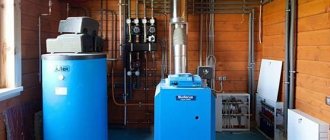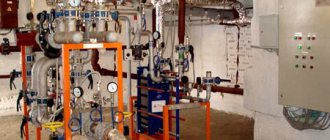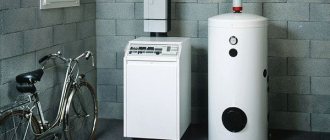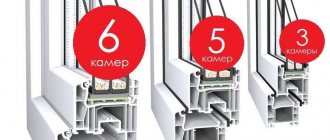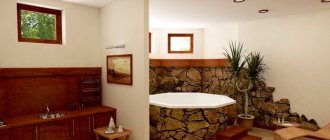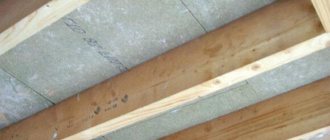Suburban construction poses questions that need to be answered before work begins. The issue of heating and water supply is at the forefront. Photo and video materials will help you correctly calculate the required ratios of the area of the house that needs to be heated, the thickness of the roof, the characteristics of thermal insulation materials, and the number of windows. Is it possible to do the installation of gas equipment yourself and only then invite specialists from the gas service to draw up the necessary documentation or entrust this important work to professionals. The results obtained are correlated with the construction site, the infrastructure surrounding the site, in particular the accessibility to various types of fuel, and it is quite a good idea to track the advantages and disadvantages of various types of boilers and their problems in operation, which is not easy to do without the appropriate knowledge.
Boiler room installation
The heating system in a private house includes not only a boiler and pipes, but also other devices and communications that are no less important for its effective functioning, located in the boiler room in a private house according to a certain, pre-calculated and specified pattern.
The heating system consists of:
- heating boiler, which is a heat generator. Thanks to the fuel burning in the combustion chamber of the boiler, the coolant heats up, and the heat from the pipes and radiators flows from the boiler room in a private house into the room.
- water heater tank. The purpose of the boiler is to provide the inhabitants of a private house with hot water. A heated coolant circulates through a tube passing inside the water heater tank, due to which the water in the boiler is heated.
- distribution manifold, consisting of a circulation pump, hydraulic distributor and comb. The main purpose of the distribution manifold is the most convenient distribution and circulation of coolant in all devices of the heating system, as well as maintaining the temperature of the coolant.
- expansion tank, necessary to compensate for the increase in pressure in the heating system due to heating of the coolant.
- a safety group that protects the heating circuit from excess pressure and removes excess air. This group includes: pressure gauge, air vent and safety valve.
- chimney. The safety and efficiency of the heating system largely depends on the correct calculation and installation of a chimney in a boiler room in a private house, the installation of which is carried out according to a certain scheme.
- pipelines, shut-off valves used to shut off the flow of the medium
- a make-up system that monitors the decrease in coolant pressure in the heating system due to evaporation or various other leaks.
- automation, which is an electronic device that allows full control of a gas boiler room in a private home.
Advantages of a liquid fuel boiler
Installing an oil-fuel boiler is much easier than a gas or solid-fuel counterpart. You can place it in the house and in the yard.
The main advantage is the absence of the need for approval and obtaining permits. All that is required from the owner of the house is to provide free access for a car with fuel and regularly refuel the boiler.
If there is no gas main near the country house, you can install a unit that runs on diesel fuel in the boiler room. A double-circuit boiler will heat the house and provide residents with warm water
To obtain 10 kW of power, about 1 liter of diesel fuel is consumed, but the exact consumption depends on the quality of the fuel. In the middle zone, with a house area of 200 m², about 5 thousand liters of fuel will be required for the heating season. The chimney must be cleaned periodically.
To install a diesel boiler, an average of 4 m² is required. If supply ventilation is provided by air flow from other rooms of the house, then per 1 kW of boiler power there should be at least 30 cmᶾ of air. With external ventilation this figure decreases to 8 cmᶾ.
Kitchen ceilings
Dampness under the floor in a private house.
What to do How to dry the underground in a private house The requirements for finishing materials for kitchen surfaces have their own nuances. A modern kitchen is both a dining room and a gathering place for the whole family. There are fumes, odors, and high humidity. How to decorate the ceiling in the kitchen of a private house, combining all the requirements of practicality and aesthetics?
- Whitewashing: plus - cheap, environmentally friendly, you can do it yourself. Disadvantage - it does not tolerate temperature changes and high humidity, it crumbles, and quickly becomes stained.
- Painting is cheap, do-it-yourself, washable, but not durable.
- Wallpaper is relatively inexpensive, washable - can be washed, gluing is not expensive, and you can choose colors to suit any interior. Changes in temperature and steam can cause peeling, especially at seams.
- Drywall. It does not belong to the category of expensive and inaccessible material, it ideally levels the surface, makes it possible to hide ceiling communications, and realize various design ideas. The disadvantage is small, but you need to be aware of it: high humidity can lead to the plaster crumbling at the seams; periodically you need to repaint it.
- The latest technologies - suspended, panel or slatted ceilings will decorate any kitchen, but these materials, which meet the requirements of this room, are in no way related to budget options.
- Plastic is the most practical material for the kitchen in terms of maintaining cleanliness, but only its expensive varieties can be considered environmentally friendly.
Little tricks
The decoration of the boiler room can be original and stylish. Brightly colored porcelain tiles combined with designer items and accessories will perfectly fit into the interior of your home. A matte surface interspersed with veins will add volume.
Cleaning will not be difficult. On a light surface, dust is not visible at all.
Doors are installed in two places. One is connected to the house, the second to the street. The entrance is equipped with additional structures. Fire-resistant metal sheet will strengthen the fire barrier. An estimated time of 60 minutes is enough to block the fire and call the fire department.
It is better to take classic, compact, no-frills lamps. Regular lamps will also work. Keep a small flashlight in a visible place in case of a power outage.
Don't get carried away with decoration. After all, the boiler room belongs to the utility rooms. The main boiler here is what you need to think about. Therefore, curb your appetites and direct your creative energy to other objects.
Which ones to choose
Floor ventilation in a private house, how to properly do ventilation. Do-it-yourself floor ventilation in a private house diagram
If you have doubts about which material to choose, you should pay attention to where this ceiling will be installed. For example, wooden flooring in the bathroom or kitchen is not a very good idea, since the likelihood of fungus increases significantly
In this case, it is better to choose tension fabrics.
When choosing ceilings for a private home, you need to focus not only on their beauty, but also on practicality. If, for example, a country house is used only in summer, and in winter it is not heated, then ceilings made of wood and plasterboard should not be installed, because dampness and cold will contribute to the rapid destruction of the materials. For such rooms, plastic panels or PVC structures are more suitable.
Provided that the house is used all year round and heated in winter, you can choose wood trim. Its advantages are strength, safety and environmental friendliness. With proper care, this ceiling will last a long time.
In this case, drywall is also suitable - it will hide all the imperfections. And after installing it, you can decorate the ceiling in different ways: use plaster, paint or wallpaper. Stretch ceilings are resistant to moisture, which is why they are suitable for any room. If you can choose, for example, glossy or matte options for the kitchen or bathroom, then fabric coverings will look more comfortable in the bedroom or office.
There is no need to create special beauty in the boiler room, switchboard and other utility rooms. There must be cleanliness and order, and compliance with all safety measures comes first. In a boiler room, all kinds of pipes usually run along the ceiling. You don’t have to cover them, but simply plaster and whitewash the ceiling. But if you really need to hide all communications from view, then you should use fire-resistant plasterboard.
It is also necessary to consider the fact that access to all pipes should be available at any moment. Therefore, you should leave holes in the required places and provide them with gratings, which, if necessary, can be easily opened and the required work can be carried out.
There are a lot of materials for decorating the ceiling, as well as options for combining different textures. All that remains is to think through the design of the room and decide which ceiling is suitable for a particular home, taking into account all the factors described above.
To learn how to decorate ceilings in a private house, see the following video.
How can you line the inside of a boiler room?
For walls made of concrete, aerated concrete or brick, choose plaster or water-based paint
Before deciding what the walls in the boiler room should be like and how to decorate them in a private house, you need to familiarize yourself with the technical characteristics of building materials for their fire resistance
When choosing the best way to decorate block walls in a small boiler room in a country house, it is important to remember that the design of the boiler room is not the determining factor when choosing a material - its practicality comes to the fore. For walls made of aerated concrete, concrete or brick, choose plaster or water-based paint
Tile or metal panels are used as decorative finishing.
Sheathing the walls of a boiler room in a private wooden house is necessary taking into account the low fire resistance of wood and the need to carefully protect it from fire. The wood must be treated with fire retardants before finishing, even if the lumber was initially treated with similar impregnation at the manufacturing stage.
Walls
Before plastering the walls it is necessary to apply a primer
When choosing a method for decorating walls, it is better to choose a material that is easy to work with. Plastering allows you to immediately solve several issues:
- quickly carry out repairs to the premises;
- level the walls;
- create a monolithic fire-resistant layer that has high strength and thermal insulation properties.
Plaster can be used as a preparatory base for finishing or as a decorative finishing layer. In the second case, you can use paint or decorative plaster applied over the starting smooth layer. The plaster is applied along beacons - metal guides fixed to the wall.
The composition is thrown between the beacons and then stretched using the rule. Before finishing the walls with plaster, the surface is dust-free with a primer - the composition clogs the pores of the base and reduces material consumption.
Tiles in a small boiler room in a private wooden or block house are the best option for obtaining a fire-resistant coating and decorating the interior of the room. It is laid on smooth plastered walls.
Floors
Porcelain tiles and ceramic tiles are the most sustainable materials
The floor in the boiler room is subject to serious loads during operation, so it is recommended to finish it with ceramic tiles or porcelain stoneware. These are the most wear-resistant, durable and fire-resistant materials.
Floor tiles for a boiler room in a private house are selected taking into account the technical characteristics. Color and pattern are not so important, although modern manufacturers offer a wide selection of colors and textures. To make the floor easier to care for and to maintain its attractive appearance for many years, it is advisable to choose large-format tiles. The fewer seams, the more monolithic and durable the coating will be.
Ceiling
Preparing the ceiling for insulation
Despite the fact that the room is not residential, all its surfaces should look attractive. For the ceiling, it is recommended to choose a suspended plasterboard system, which allows you to lay communications and insulation between the ceiling and the gypsum board sheets.
Installation of this design takes a little time:
- A metal frame made of profiles is fixed to the ceiling.
- Lay insulation and wiring for lamps.
- Hem the drywall using self-tapping screws.
- Using a special attachment on a drill, holes are cut out for spotlights and wires are brought out.
- Then you need to putty the screw heads and joints.
Commissioning of a roof boiler room
- Preparation of design documentation and approvals.
- Carrying out technical work on the installation and arrangement of a thermal station.
- Measures aimed at shock absorption and noise insulation - noise pollution is not allowed to exceed 60 dBA inside the boiler room and 35 dBA in nearby residential areas. The result is achieved in two ways:
- selection of heating and other equipment equipped with soundproof casings.
- carrying out work to install noise-absorbing and vibration-reducing barriers.
- Organization and implementation of maintenance work - personnel undergo special training and receive the appropriate license. After installation of boiler equipment, it is allowed to conclude an agreement with residents for the maintenance of boilers and related equipment.
Types of ceilings in a private house
Fire safety in an electric boiler room
Block-modular boiler houses (mobile, autonomous) with a capacity of 35 - 3000 kW are common. Maximum service area up to 30,000 m². Requirements:
- distribution devices (minimum 2 sections);
- variable frequency drives;
- soft start and blocking devices;
- automatic switching on of reserve;
- laying of networks is open in boxes or in channels (wires in the lining), with the exception of wet areas and fuel supply;
- electrode boilers - three-phase, with connection to industrial frequency networks;
- pipelines with insulating inserts;
- grounding, grounding;
- the transformer station is not located in the boiler room, but nearby;
- electric boilers with protective fencing;
- all nodes are isolated from the ground and pipelines;
- automatic shutdown with alarm if there is a deviation in system performance;
- sign “Caution! Electrical voltage" at the input.
Fire safety rules for the operation of boiler installations with electric boilers take into account the PUE.
Design ideas
When remodeling the ceilings of an old house with beams, the voids between them are often used to fill with communication wiring, and then covered with ceilings. Another option is to use them after processing as the main element of the ceiling design, which gives a special charm to a private home. The ceiling in the house can be decorated in a classic style, using one type of material. You can do things differently. Combinations of different structures and shapes, multi-level designs, and decoration with original lighting make it possible to make each home individual and special using simple materials.
Glossy stretch ceilings made from Pareo film – 3.2
The latest development of frost-resistant vinyl has helped expand the temperature limits for the use of glossy stretch ceilings. French film Pareo - 3.2 is capable of performing the function of a ceiling at 30 degrees below zero. The minimum declared destruction temperature is called -50C.
The Pareo - 3.2 film feels like silk and is capable of stretching by 10% of its length, followed by an independent return to its original size. This property of the coating has found practical application during installation, which is carried out without preheating the film. This installation of a stretch ceiling is called “cold”.
With this method, there is no need to warm up the entire room, which has led to an even greater simplification of installing a suspended ceiling in the garage.
The color range of vinyl film makes it possible to create a unique design for an unheated garage. The reflective surface does not reduce its qualities when the temperature drops and is not afraid of moisture getting on it. It is as easy to clean as a regular glossy stretch ceiling.
Attaching the film is similar to standard installation of a PVC ceiling. The film is fixed in traditional baguettes - brackets.
Modern options
What task (as opposed to the traditional version) can all types of modern ceiling materials cope with? The main advantage of the newfangled options is their undemandingness on the base surface, which may not be perfectly flat. Agree, this is a significant plus, isn’t it?
Admire: a “mix” of suspended and tensioned structures
Suspended structure
The popularity of this option does not fall; sometimes it is combined with more modern technologies, but the life of suspended structures continues.
What is the order of work? A special frame is attached to the base, onto which drywall or whatever material you like is mounted.
The design of the frame itself can contain as many levels as your heart desires, the main thing is to be sure that the frame will withstand the weight of the materials that will be attached to it.
What could serve as such a design?
- Drywall is the most common option, which virtually every repairman knows how to work with. Metal screws are used to attach drywall sheets to the frame. Then the joints between the sheets are puttied. And then it’s up to you to decide. You can simply paint or cover the surface with what you like, for example, tiles, wallpaper or other materials you like.
- Cassettes or slabs, which can be structures made of the same plasterboard, or glass, or metal, or mirrors, or other materials. The only thing is that for this option you will need a special frame - in the form of cells.
- Reiki. Experts say that this type of structure is the easiest to install. Even a beginner can handle attaching slats to the ceiling. The frame of such a ceiling is made up of guide rails attached with hangers parallel to each other. The slats you like are attached to them.
Stretch ceiling
With the help of structures of this type that are gaining momentum, it is possible to achieve a perfectly flat surface. And there is no need to talk about beauty. True, it is unlikely that you will be able to carry out such work on your own if film is chosen as the material, unless you are a master installer of such structures who decided to work for the benefit of the beauty of your own home.
So, what does a suspended ceiling consist of? As with the hanging option, you need a frame. Most often, this design is a special baguette that is attached around the perimeter to the walls. A fabric is stretched onto it, the size of which exceeds the base surface by about 10%. The material must be tucked into the baguette using a special spatula for such work. The next stage depends on what the suspended ceiling is made of. If the fabric is chosen, then the work is completed, except that the perimeter is decorated with baguettes. In the case of film, you need to use special equipment - a heat gun.
Stretch ceiling, fantastically beautiful, isn't it?!
Primary fire extinguishing agents
The boiler room has subclass F5.1 (industrial buildings), accordingly, they comply with the standards for fire extinguishing agents.
A fire shield is needed if there is no fire hydrant, AUPT, and the distance to water intake points is more than 100 m. A box of sand (from 0.5 m³) is required for fire class. B, E. The procedure for using primary fire extinguishing agents is prescribed in the safety instructions.
What fire extinguishers should be in the boiler room?
In boiler rooms, the fire class is usually A, B, C, and also E (electric boiler fire). According to the table NN 1 and 2 PPR (post. N 390) conditions for manual fire extinguishers are as follows:
| Fire class | Number and fire extinguishing capacity of fire extinguishers |
| A | 2 – 6A 1 – 10A |
| B | 2 – 144B 1 – 233B |
| E | 2 – 6A, 144BCE 1 – 10A, 233BCE 2 – 144BCE 1 – 233BCE |
| WITH | 2 – 6A, 144BC 1 – 10A, 233BC 2 – 144BC 1 – 233BC |
According to the table 1 NPB 166 list of fire extinguishing means in the form of fire extinguishers is as follows:
| Boiler room category | Maximum area, m² | Fire class | ORP, 10 l | , l | for 2 (3) l | , l | |||
| 2 | 5 | 10 | 2 | 5 (8) | |||||
| G | 800 | B | 2 | – | 2 | 1 | – | – | – |
| C | – | 4 | – | – | – | ||||
| G, D | 1800 | A | 2 | 4 | – | – | – | ||
| D | – | – | – | – | – | ||||
| E | – | 2 | 2 | 4 | 2 | ||||
According to SP 41-104-2000 clause 14.2, mobile OPs are prescribed for areas up to 150 m³; additional standards are in Table. N2 NPB 166. It is recommended to follow the rule: the boiler room must have at least 2 fire extinguishers.
General standards
The boiler can be placed in many places:
- in the attic;
- in a separate building;
- in an autonomous module - a mini boiler room located in a container;
- directly in the house;
- in the annex.
When planning your home, the best option would be to place the boiler in the attic or basement. However, if the house has already been built, then it is better to choose an extension or a separate building.
A common option is a mini boiler room, in which all equipment is placed in a container. The small size allows you to install it anywhere.
In the photo you can see such a mini boiler room.
There are also mobile boiler houses, which are turnkey mini buildings. The walls are made of sandwich panels finished with non-combustible materials.
The design of the boiler room depends on the type of boiler being installed, which can be gas, solid fuel and electric.
However, it is not enough to choose the type of heating and select a suitable room; you also need to draw up a project. The project must contain an equipment layout diagram and display all standards.
For clarity, a diagram of the boiler room arrangement is presented.
The project also needs to be coordinated with special government agencies, this mainly concerns gas equipment.
It is imperative to comply with the general requirements for all types of boiler rooms:
- no more than two boilers are allowed to be installed in one boiler room;
- the walls are made of non-combustible material, such as brick or concrete;
- the floor must be made of concrete or covered with a steel sheet and tiled;
- the use of any flammable materials is prohibited;
- Only a fire door is installed;
- the door of the boiler room and the adjacent room must open outward;
- in an attached building, one door should go into the house, and the other door should go out into the street;
- unobstructed access to the boiler equipment must be ensured;
- the hood should provide three air exchanges per hour;
- A window must be installed, which must have a window.
What is included in the components of the boiler device?
Naturally, all boilers have obvious differences from each other, but in most cases their components are the same; let’s look at the standard devices:
- The boiler, which is responsible for heat and is the main element for heating the house, is where the fuel combustion chamber is located and energy is directly released that heats the entire building.
- A reservoir for water that is heated is used in systems that have two circuits, that is, they are aimed not only at heating, but also at heating water.
- An expansion tank that regulates the pressure in the boiler and ensures the integrity of the pipes.
- The distribution manifold ensures uniform distribution of heat throughout all rooms; there is also a pump that helps the manifold perform this function.
- The chimney provides the exit of combustion products from the room.
- Pipelines and special taps help heat spread throughout the house.
Boiler room in the house - main types for private properties
The boiler room does not have any specific design. In a private house, you can install any boiler room that the owner himself desires. There are no uniform parameters. The size, location and equipment for the boiler room are chosen by the owner himself.
Heating equipment requires strict control. Often it must be installed separately from the main building, since such equipment is dangerous. Therefore, you need to fulfill certain requirements to protect yourself and your loved ones.
The boiler room, also called the furnace room or boiler room, can be located both outside the house and inside it. It can be placed in many different places: on the ground floor, in the garage, in an extension or in the basement. However, it is best to place it at some distance from a country building.
Type of boiler room by its location:
- A built-in boiler room in a house that does not have a separate room. All equipment (boiler, pump, boiler) can be located in the kitchen or hallway. This option is the cheapest and is only suitable for a small boiler.
- Boiler room built into the house, but located in a separate small room
- The boiler room, which is located in the annex. This option is suitable for equipment that creates a lot of noise.
- A separate mini-boiler room located at a distance from the building.
The cheapest option is a boiler room in the kitchen, suitable only for a small boiler. A convenient option for a boiler room for heating is inside the house, but it is located in a room intended for it. The boiler room attached to the room may have a separate door. The safest is the boiler room, which can be built separately from the main dwelling, but this is very difficult and expensive to do.
Installation Tips
The heating system in each private house is individual - and yet there are clear principles and criteria that are more or less universal.
The procedure for piping heating and hot water supply boilers with your own hands implies, first of all, division into open and closed groups.
In the open version, the heating boiler is placed lower than all other components. The expansion tank is raised as high as possible: it is the height difference between them that determines the overall efficiency of the entire equipment.
An open circuit is the easiest to prepare
In addition, it is non-volatile, which is very important for remote locations and for areas where power outages are frequent. But we must understand that continuous contact of the coolant with atmospheric air inevitably leads to clogging with air bubbles
The coolant will circulate slowly, and it is impossible to speed up its flow through design schemes. If these points are important, and if there is a desire to also reduce coolant consumption, it would be more correct to make heating using a closed circuit.
If the boiler room is located in an extension, then it must be adjacent to a solid section of the wall. In this case, at least 1 m of free space should be left to the nearest window or door. The building itself is made of fire-resistant material with guaranteed combustion resistance of at least 45 minutes. Wall-mounted boilers are mounted only on walls made of fireproof materials. Carefully ensure that all other walls are at least 0.1 m away.
If powerful (200 kW or more) boilers are used, it is imperative to prepare a separate foundation for them. The difference between the height of this foundation and the height of the floor cannot exceed 0.15 m. When it is planned to use gas fuel, it is necessary to install a device on the pipe that urgently turns off the gas in a critical situation.
Furnace rooms are equipped with unstrengthened or weakly reinforced doors: during an explosion they are thrown out, and this reduces the risk of destruction of the entire building.
When installing a boiler room built into the house itself, it is allowed to install thoroughly reinforced doors. However, they are subject to another requirement: to hold back the fire for at least ¼ hour.
To improve ventilation, in any case, a hole is made in the lower third of the door, covered with a mesh. The entire volume of walls is finished from the inside with fireproof materials. This must be done as soon as the installation of the boiler and its connection to the communications are completed.
The number of circuits is also important. If you plan to limit yourself to heating, it is quite reasonable to choose a single-circuit boiler
Please note: it can also be used for hot water supply, but only in conjunction with a boiler. Installing a boiler is justified under 2 conditions: a lot of hot water is consumed and there is a lot of free space. Otherwise, it would be more correct to order a double-circuit boiler.
Ventilation communications are mounted in the wall opposite from the boiler. A mesh and damper must be installed in the ventilation pipe. In boiler rooms located in a separate room, you will have to make a ventilation duct in the door with louvres.
Sources
- https://www.kotel-modul.ru/balashikha/useful/kotelnaya-v-chastnom-dome
- https://stroy-podskazka.ru/kotelnaya/v-chastnom-dome/
- https://hvac-life.ru/kotelnaya/trebovaniya-k-kotelnoj-v-chastnom-dome/
- https://kak-sdelano.ru/otoplenie/kotelnaya-v-chastnom-dome
- https://sovet-ingenera.com/otoplenie/kotelnaya/kotelnaya-v-chastnom-dome.html
- https://dom-i-remont.info/posts/otoplenie/princzip-raboty-gazovoj-kotelnoj-elementy-sistemy-i-trebovaniya-k-nej/
How to decorate a wooden ceiling in a private house
The construction of newfangled buildings made of concrete, glass and plastic is gradually fading away. Man's craving for the natural and natural is reflected in the popularity of country houses made of wood and interior wooden decoration. What about the ceilings in this case? Of course, you can use all available types of finishes, but to maintain a natural “wooden” style, the best options are:
- Lining. Natural wood plank panels were once used as upholstery materials for railroad cars, hence their name. The most popular types of wood for its manufacture are hardwood oak, hornbeam and aspen.
- Reiki "block house". An excellent invention for a wooden house: it does not require preliminary preparation, hides all defects, excellent heat and sound insulating material, an innumerable number of design solutions. There is only one drawback - high cost. The material for making such blocks is almost any type of wood.
In finishing a wooden ceiling, plywood, wooden floor beams, special fake beams, boards and slats are also used. An interesting solution for wooden ceilings is a combination of wood inserts in the design with tension elements or diverse plasterboard structures.
Types of material
The following types of insulation are obtained from waste from metallurgical production and the energy industry:
- domain;
- metallurgical;
- fuel and coal.
Different types are used to insulate structural elements of a house.
Domain
The material is obtained by smelting cast iron. The composition includes the remains of rock, fluxes and fuel ash. The pieces are very porous, the material is free-flowing.
In private construction, the fine (heavier) fraction is used to fill cavities in walls or to screed concrete floors. The large fraction is light in weight and is suitable for backfilling attic floors.
This type of raw material is used for the production of slag heat-insulating materials.
The most suitable for insulation is slag pumice, which has good heat and sound insulating properties. It also goes into filler for cinder blocks.
Metallurgical
Metallurgical slag can create excessive stress on the foundation
This type most often includes waste from nickel and copper smelters and steel mills.
The material consists of sintered pieces of various fractions. They contain a lot of metal oxides, which is why the mass of the composition is large.
Fuel
The raw materials for production are the remains of fuel oil and coal burned in boiler houses. The fraction and properties depend on the type of combustion (chamber or layer).
Residues of fuel are hygroscopic, so before filling they must be dried for at least 2 months without exposure to precipitation.
It is used for filling cavities in brick walls or under concrete screed on floors and ceilings.
Installation work
In general, installation of equipment is the same for all types of heating systems.
Therefore, we will consider installation using the example of the most common and at the same time the most difficult to install and operate gas boiler with your own hands.
The installation diagram of heating systems is presented below.
Gas boilers come in two types: wall-mounted and floor-mounted.
Wall model
Installation is carried out at room temperature from +5 to +35 degrees and air humidity - no more than 80%.
Installation begins with finishing the walls, which need to be covered with heat-resistant material 2 mm thick.
To do this, a hole with a diameter of 15 cm is punched at the bottom of the wall at a height of 30 cm from the floor with access to the street, and a plastic pipe is inserted. A check valve is installed on the inside of the pipe.
The exhaust hole is made in the same way. The ventilation diagram is shown in the figure.
Ventilation is especially needed if the window and door are sealed.
Now you can install the equipment itself. First, a bracket for the boiler is attached to the wall, which is usually included in the package.
The minimum height of the boiler is 80 cm from the floor. The bracket must be attached parallel to the floor.
When doing the work yourself, you can check this with a building level.
To prevent clogging of the heat exchanger, an angular strainer must be installed on the water supply pipe. It is advisable to install ball valves on the filter on both sides, as well as on the nozzles.
In the future, this will make it possible to change filters without draining the water from the system. After this you need to make a connection to the chimney.
Now you need to connect the pipes to the corresponding boiler pipes, having first removed the plugs from the manufacturer. The water supply pipe is connected at the top, and the return pipe at the bottom.
It is better to connect using gas welding. When installing it yourself, a slope of heating pipes of no more than 5 mm per 1 m of pipe is allowed. The pipe connection diagram is shown in the photo.
The next step is the strapping. The boiler must be connected to three systems: gas, hydraulic, electric.
It is better to connect the equipment to the gas pipeline not with your own hands, but with the help of a certified specialist.
Electrical and hydropiping can be done by hand. The hydropiping diagram will allow you to clearly see the connection.
Tying is carried out subject to the following conditions:
- Hot gases and water in the heat exchanger must move countercurrently, otherwise an explosion may occur. After completing the hydropiping, all connections must be carefully inspected and it is advisable to repeat the inspection some time later;
- If there was antifreeze in the heating system, it must be drained and the equipment washed several times to avoid an explosion.
Before installing the boiler, the following must be installed:
- valve/gas tap;
- counter;
- gas alarm;
- thermal shut-off valve.
The electrical system must be equipped with automation that will prevent short circuits and overheating. Before the first start, the equipment must be filled with water to check for leaks.
But first you need to disconnect the boiler from the network and open the built-in valve located at the bottom of the boiler.
Floor model
Floor-standing boilers are much more powerful than wall-mounted ones, so they are most often placed in a separate room.
After installing a boiler with a boiler, the equipment must be connected to the chimney, and then to the heating system of the house with the installation of a filter that protects against clogging.
When connecting to a water supply, the tap into the water supply must be placed as close as possible to the entrance of the pipe into the house.
This will ensure uninterrupted water supply and high water pressure in the system. Then the equipment is tied up.
Thus, you can install heating equipment in a private house with your own hands, and compliance with all the rules and regulations for the construction of a boiler room, as well as for the installation of equipment, will ensure long-term and safe operation of the system.
Installation
Installing the boiler on a wooden floor is possible with your own hands without the help of a specialist. To carry out work there is no need to obtain special permission from the relevant authorities. It is necessary to prepare a special, well-ventilated combustion chamber. It is equipped in accordance with fire safety requirements.
There are a number of requirements regarding the firebox design:
- it is necessary to install a window in the room for ventilation;
- installation of utilities (ventilation, water supply system, sewerage).
The glazing area depends on the volume of the room: at least 0.03 m2 for every 1 m3 of furnace volume.
Foundation
Particular attention should be paid to the foundation for a boiler in a log house. When installing a floor-standing unit with a power of up to 50 kW, you can use a cement-sand screed as a base, but when installing more powerful units this will not be enough
You will need a separate concrete foundation, which will protrude 25–30 cm from the dimensions of the boiler installation.
When installing the unit, certain requirements regarding the floor material are imposed. The equipment must not be installed on a flammable wooden base. If it is not possible to pour a concrete foundation, then the boiler in a log house is installed on a podium made of refractory brick, sheet metal or asbestos. The base should protrude from the dimensions of the boiler by at least 15 cm on each side and 20 cm in the firebox part.
Ventilation
The correct supply ventilation system can increase the efficiency of the boiler installation and ensure the required level of fuel combustion. Utility parameters are calculated based on the size of the furnace and the power of the installed equipment.
For normal operation of a small boiler with a power of up to 35 kW, it is enough to punch a small hole with a cross-section of 30 × 30 cm on the wall opposite the boiler in the lower level to provide fresh air flows. An exhaust vent with a cross-section of 40 × 40 cm is also equipped at a distance of 30 cm from the ceiling level in the opposite part of the room.
Chimney
Any heating equipment in which fuel is burned must be equipped with a chimney. The location of this channel is indicated at the design stage of the building. If the chimney is not provided for in the design documentation, it is made independently from brick or special material.
A modern version of the chimney are insulated sandwich modules, which are made of stainless steel and insulation (mineral wool). The exhaust gas removal shaft is assembled from parts of the required diameter. The standard height of the components is 1 m. There are certain requirements for the chimney of a solid fuel boiler:
- constant cross-section along the entire length of the pipe;
- shaft diameter for household models is within 15–20 cm;
- no tilts or bends;
- It is prohibited to join sandwich modules within the floor slab.
If necessary, you can move the chimney, but no more than 1 m from the standard position. To prevent the possibility of fire in roofing materials or other building structures, chimneys are equipped with spark arresters.
Connecting the unit to the heating system
After installing the boiler, preparing the ventilation system and installing the chimney, they begin piping the heating unit
One important rule must be observed: under no circumstances should cold water come into contact with the heat exchanger of a running installation. Due to the temperature difference, condensation forms on the walls of the combustion chamber, on which soot settles and turns into viscous stable accumulations
Sticky deposits are difficult to clean off and reduce the efficiency of installed equipment.
Standard piping with a three-way valve and bypass helps reduce condensation. The circuit is adjusted to the coolant temperature in the range of +50–55 °C. As a result of heating, the water moves along the circuit of the heating system until it warms up to the specified parameters. After this, the three-way valve is turned on, which mixes the cooled liquid from the return of the heating system.
When piping a solid fuel boiler, it is necessary to proceed from the manufacturer’s requirements, which are set out in the instructions for the specific model of the unit.
It is important to correctly connect the burner to the control unit. European models of heating equipment often have a fire protection system
The mechanism is connected to the central water supply.
Boiler room in a private house.
When building a private house, the location for installing the boiler must be selected in advance.
The solution to this issue is primarily related to construction work. If you have started a serious repair or reconstruction of a private house “without amenities”, and plan to turn it into comfortable housing, resolving the issue of where to install the boiler and choosing a heating system should be a priority. After all, what kind of comfort can we talk about without a high-quality heating system?
It happens that the old layout does not allow placing a boiler room in the house without violating current requirements and standards. But if you still fit a boiler room into a small room without knowing the rules, you will get a lot of small and sometimes major troubles.
Where to place the boiler room inside or outside the house is a very important question. And it should be solved naturally in the first stages of construction or reconstruction of a private house.
During reconstruction, you can place the boiler room in an attached room, although, as a rule, such architectural solutions hopelessly spoil the appearance of the house. The optimal solution in this case would be a separate boiler room.
In new construction, a separate room is usually allocated for the boiler room, although in this case the boiler does not have to be installed inside the house. It is quite possible to install it in a special room, on a separate foundation and at a certain distance from the house.
I will not burden you with the advantages and disadvantages of these two options for installing a boiler room in a private house, but I will only try to explain in detail the standards and requirements for installing boiler rooms, and why we must unquestioningly comply with these requirements.
Workflow Description
Before finishing a boiler room in a private house, you need to decide on the materials you will use. We will figure out what is needed for the floor, walls and ceiling, and also consider the basic requirements for window and door structures.
Porcelain tiles are an excellent solution for the floor in the boiler room
This part of the room experiences the highest loads, so the best option for finishing it is porcelain stoneware or floor tiles. To work we need a certain set of materials:
- Tiles in the right quantity, color is not important, the main thing is that the material is durable and wear-resistant;
- Tile adhesive, it is best to use compounds with increased fixation to ensure strong fastening of the elements to the surface;
Tile adhesive must be of high quality
It is still better to make the walls in the boiler room with tiles rather than with water-based paint
Allah, no one argues with this. Based on practical considerations, ceramic tiles on the walls of a boiler room are really better than water-based paint.
Tell me, what can you use to decorate the walls of a boiler room in a frame house? There are already DSP sheets on the walls. Thank you!
Semyon, the walls made of cement particle boards in the boiler room can be painted with heat-resistant paint. Before this, the walls must be primed with deep penetration adhesive primer. DSP walls can also be faced with ceramic tiles. For example, clinker.
Please tell me what is the best way to decorate the walls near a floor-standing gas boiler? And to what height?
Marina, if the gas boiler is located close to the wall, then it should be lined with heat-resistant material. For example, it can be plastered with heat-resistant plaster, and then painted with heat-resistant paint or covered with heat-resistant tiles, such as clinker.
Is it possible to make the ceiling in a boiler room from plasterboard and then plaster and paint?
Alexander, yes, the ceiling in the boiler room can also be lined with plasterboard. Provided that the boiler room has an effective ventilation system. Best of all, to be on the safe side. use fire-resistant drywall (GKLO). It is pink in color.
Hello! Please tell me what kind of drywall is used on the walls in the boiler room, double-layer or single-layer and what can be laid underneath it
Olga, how many layers of plasterboard there will be is not so important. The main thing is that the material in the boiler room is fire-resistant. It is not difficult to distinguish fire-resistant sheets from other types of drywall
The color of the cardboard covering the core of the sheet is pink, while for simple plasterboard it is gray, and for moisture-resistant plasterboard it is green. Under the cardboard of the gypsum board sheets there is the same gypsum, reinforced with reinforcing fiberglass and reinforced with clay. If a fire occurs and the top layer of the sheet burns, its core remains in its original state longer than that of gypsum board or plasterboard.
The fire resistance limit of drywall without fire retardant additives is about 20 minutes. This means that such sheets are completely destroyed after continuous exposure to open fire for this time. Fire-retardant sheets are much more resistant - they are destroyed only after about 45 minutes after the start of the fire. In addition, the core contains about 20% (of the total mass of the sheet) of crystallized water, so during a fire it acts as a “firefighter” for itself.
We bought 3 curtain rods for 3 rooms. Needs to be fixed to the ceiling. The ceiling is concrete.
Hello, in my boiler room the boiler is located close to the wall, and the wall freezes, please tell me what is the best way to insulate the wall and what to cover it with?
Elena, the walls near the boiler are best insulated with extruded polystyrene foam. It is fire resistant. And it is best to cover them with clinker tiles. It is heat resistant. Or sheet metal if you don't care about the aesthetics of the walls.
Finishing a boiler room in a private house photos and materials
Finishing the boiler room is a very important stage of construction. You need to arrange and decorate the premises very competently - this is the key to your safety. To do everything correctly and at the same time beautifully, you need to fulfill all the requirements and adhere to the standards.
Before you start finishing the room, you first need to determine what material you will use for these purposes? There are a large number of materials for this, but the most alternative option is tiles.
After looking at various photographs of individual options for finishing boiler rooms, you need to make a choice or create your own room design and bring it to life.
Non-combustible finishing materials:
- Ceramic tile. This is an ideal solution for wall decoration.
- Porcelain tiles. They usually cover the floor of a boiler room, as it can withstand heavy loads.
- Xylolith-fibrous leaf. This is an environmentally friendly material that can withstand very high temperatures (1000 degrees).
- Fireproof and heat-resistant plaster. It can withstand an open flame for several minutes. It can also be painted in different colors without losing its fire-resistant properties.
The decoration inside the boiler room can be made from inexpensive materials, but they must meet all the requirements. The price of some of them can even be very modest. The main thing for a boiler room is not its finishing, but the equipment. This is what you need to spend your savings on in order to feel safe.
Interior planning
The appearance of the boiler room should be selected in such a way that it is pleasant to stay in it and perform the necessary work. All things are located in their places, each element is placed taking into account ease of use. The room should not only be comfortable, but also functional and meet all safety requirements. It is best to give preference to light shades when decorating the interior; uniform and bright enough light is appropriate in the room to easily see all the details when servicing equipment. Lighting sources can be very simple; in the future they must be covered with a protective mesh. Decorative elements are unnecessary, the main thing is convenience and safety.
In spacious boiler rooms, you can place several shelves in the free zone, on which things often used at work will be stored. In this case, all racks must be exclusively metal. It is strictly prohibited to place flammable materials in the premises. To prevent fire, it is recommended to purchase a fire extinguisher and fire-fighting accessories.
Boiler room project for a private house selection criteria
An important stage in the construction of a boiler room intended for a private home is design. You won’t be able to create a project yourself; it must be handled by a specially trained designer. He, in turn, must have all the necessary documents.
All calculations are performed on the working drawings, as well as the selection of equipment necessary for construction. And all actions and decisions are described in a special note. All these documents will be required to be submitted to the relevant authorities.
The approval process, which can take several months, depends on the complexity of the project. If there are no complaints and the documents are stamped, then you can begin construction
When a project is being done, then you need to choose the type of boiler room, paying attention to some criteria
Criteria to pay attention to:
- Heating mode;
- Type of energy carrier;
- Installation location;
- Ventilation;
- Lighting;
- Size: the height should be approximately 2.5 m, and the volume of the entire room should be 15 cubic meters.
Examples of boiler houses can be different: gas, solid fuel or electric. A gas boiler room is the most unsafe; the standards and requirements for it are very strict, because the gas is explosive. Solid fuel type devices are less explosive, but they are also installed outside the home. Some boilers can even operate on wood. Such a boiler room is called a stoker. Properly installed electrical wiring is the key to safety. Grounding must be done.
Boiler room category for explosion and fire hazard
The boiler room is a room with a functional fire hazard class F5.1, respectively, categorized according to SP 12.13130. In SP 89.13330 it is assigned cat. D, but this provision is not categorical - calculations are carried out individually.
The boiler room almost always has a cat. D. In exceptional cases, if the calculation of the category shows this, one of the positions B is possible. Different parts of the building may have different values (see SP 89.13330).
Built-in, attached, roof-type structures are made with fireproof parameters no lower than those of the structures they serve. Detached buildings must fully comply with the rules for production facilities.
Other parameters for the PB classification are:
| Type | Fire resistance degree | Structural fire hazard class |
| Separate attached, built-in | I and II | C0 |
| III | C0, C1 | |
| Separate with reliability of release 2 tbsp. | IV | C0, C1 |
| Roof | III | C0 |
Area and standards for the boiler room
The area of the boiler room in a private house in an attached room, basement or basement, kitchen depends on the power of the boiler and the type of fuel. The more powerful the unit, the more air it will need for combustion. The dimensions of a boiler room for a private house must be calculated: there must be enough space not only for equipment and its decoration, but also for normal functioning. With a boiler with a power of up to 150 kW, the norm for the volume of a boiler room in a private house should be at least 15 cubic meters.
A gas boiler
It is the most demanding boiler system. With a minimum wall height of 2.5 m, the volume of the room must be at least 15 cubic meters. As for the decoration of the room: a minimum floor area of 6 cubic meters, a window - more than 0.5 square meters, a door more than 80 cm wide, a chimney above the roof ridge of at least half a meter, the presence of a sewerage system to collect condensate. In addition to all of the above, gas services require a gas detector.
Electric boiler room
Any boiler room for a country house and beyond is not 100% safe. But the least likely emergency situation, including for a boiler room in a wooden house, is electricity. This boiler system allows you not to fill the room under it. You can install and finish the firebox yourself in a country house. The boiler and equipment do not emit harmful substances or gases. The main thing is to ground the electrolytes; it is imperative to carry out competent work.
Solid fuel boilers
Such equipment is no less demanding than gas equipment. The unit cannot be finished; access to it is open. There is a steel floor at a distance of 1 meter on each side. The window should be 0.08 m2. The minimum size of a boiler room in a private house must be at least 8 square meters. The chimney is smooth along its entire length with special holes for cleaning. And if the combustion is carried out with coal, the wiring must be sealed, since coal dust explodes at a certain concentration.
Diesel boilers
Installation of such a boiler system occurs without problems. You don't even need permission. The best place for a boiler is the basement of a country building, where containers for storing a large volume of fuel can be placed. Such a room requires finishing for safety reasons. In principle, there are basic requirements. They are indicated in the project documentation and cannot be ignored.
The finishing of any boiler room in a building, as well as one that stands alone, is done using ceramic tiles or any heat-resistant material. The finishing must comply with all fire safety standards. Anything that can catch fire must be a protected metal device or any other non-combustible material. And finishing a boiler room made of wood requires special attention, including the installation of fire extinguishing systems.
The finishing of the floor needs to be given the same attention. It must be smooth, made of cement-sand screed
The device equipment must be leak-proof. To do this, you need to organize a drainage ladder and place the boiler on a small foundation. This will help the boiler remain intact, waterproof and airtight. The boiler at altitude will not come into contact with water, and such a force majeure situation is quite possible.
If the boiler room is attached, then it should be located at the back of the building, away from doors and windows (at least a meter). In the event of an explosion or emergency, this will protect you from the worst. The walls and structure of the boiler room must withstand fire for up to 40 minutes. The higher the ceiling, the better (more than 2.5 m). The door should open outwards. And if there are additional doors from the living space to the boiler room (which is very convenient in winter or during rainfall), then the doors should open into the boiler room.
Selecting and installing the device
For those who want to know how to improve a boiler installation with their own hands, it is necessary to remember that at the beginning of the installation it is necessary to select a set of necessary equipment. The boiler is selected depending on the climate conditions and the volume of rooms for heating.
To calculate the boiler power for a small space of no more than 200 square meters, where the ceiling surface will not be more than a few meters, and the wall surface is insulated, as well as window and door openings, it will not require very much effort. For such purposes, the footage should be multiplied by the power of the installation, as in the photo of the heat-generating installation, per every 10 square meters of space. This indicator was derived through an experiment for a wide variety of Russian climatic territories.
Professionals will arrange the necessary additional equipment, looking at the project documentation, connect the device to the chimney, set up an automatic system, and also carry out commissioning work.
Traditional finish
If you are a conservative and just want to refresh and level the ceiling, which was once made according to the “Soviet” standard, this is your right. So, the work on such a project will be divided into two blocks of work: roughing and finishing.
What are traditional ceilings made of? In this case, during the renovation we have an old ceiling, otherwise we would have to start with plaster. If it is already present, then the task becomes easier. For repairs you will need putty, primer, paint and water - that’s all the materials.
Classic is always in fashion, so don’t think that plastering and painting the ceiling will make your apartment “Soviet”, because the design depends on a lot of other components, as you can see
Briefly about what processes they will go through:
- Cleaning old coating. First, the outer layer is removed using a spatula. Then the remaining paint/whitewash must be washed off with water.
- Sealing cracks (if any).
- Primer.
- Treatment with rough putty.
- Finishing putty.
- Cleaning the coating with sandpaper.
- Primer.
- Whitewashing/painting.
By the way, the final stage may be different, not so conservative. You can stick wallpaper or special tiles - everything is in your hands.
